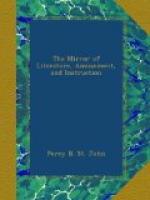We have frequently remarked small radiant and arborescent crystallizations on dirty windows in London, and have found them to consist of sulphate of ammonia. This salt, or at least, sulphite of ammonia (which becomes sulphate by exposure to air), is an abundant product of the combustion of coal.
Brande’s Journal.
* * * * *
Indigo.
This valuable plant, which gives rise to as great speculation in India, as hops in England, is much injured by wet weather; although the rapidity of the growth of plants during much rain, in the temperature of the tropics, is extraordinary, yet a proportional deficiency in all that characterizes the vegetable world necessarily follows. This we find to be the case with all forced vegetables; and the mildness of the radish of hastened growth, when contrasted with the highly pungent and almost acrid flavour of the slowly and gradually advanced one, may be adduced as explanatory of this observation. Hence, it is practically well known to manufacturers, that the indigo plant, however fine and luxuriant, as is the natural result of much rain, is very deficient in produce, and a similar loss is experienced even if the plant, without the fall of too much rain, has grown up under cloudy weather. Sunshine, much and continued sunshine, is essentially necessary for the proper exercise of those secretory organs by which this peculiar drug is formed and perfected.
Indigo leaves produce two dyes—blue and yellow; but the refuse leaves, when boiled for an hour and a half, will render the water yellow, tinged with green. This water, kept boiling for two hours, (supplying the loss by evaporation), will, when filtered, afford a precipitate, which, when dried, will in colour be a dun-slate, and in quantity perhaps about equal to the blue extract such leaves have produced. This observation, as it can lead to no practical advantage, is made for the man of science, rather than the man of business.—Mr. C. Weston—in Brande’s Journal.
* * * * *
Chain Bridge.
Mr. Disney has lately erected at his seat the Hyde, Ingatestone, Essex, a suspension bridge of common chain, which is much cheaper than either wood or brick. It is fifty feet long, and four feet wide. The whole cost of material, and workmanship scarcely exceeded 30_l_. Upon a rough estimate, a wooden bridge of the same span would have cost from 80_l_. to 100_l_., and a high arch probably from 150_l_. to 200_l_. The piers or posts supporting the chains are of oak, but should they in ten or fifteen years decay, 10_l_. in money, and three days in time would set it up again.—Brande’s Jour.
* * * * *
Stone Roofs.
The Romans employed pumice in building their arched incombustible roofs. This porous material possessed the additional advantage, when combined with good cement, of rendering the arched surface one united petrifaction, opposing (in consequence of its firm union) little lateral pressure, comparatively, against the sustaining walls.




